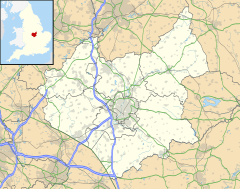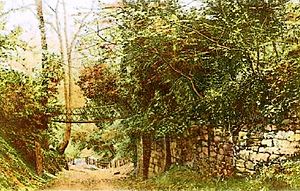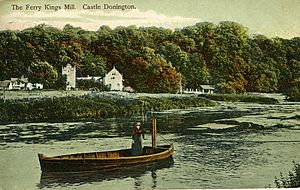King's Mill, Castle Donington facts for kids
Quick facts for kids King's Mill |
|
|---|---|
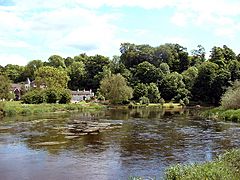 |
|
| Population | small |
| OS grid reference | SK446272 |
| District |
|
| Shire county | |
| Region | |
| Country | England |
| Sovereign state | United Kingdom |
| Post town | Derby |
| Postcode district | DE74 |
| Dialling code | 01332 |
| Police | Leicestershire |
| Fire | Leicestershire |
| Ambulance | East Midlands |
| EU Parliament | East Midlands |
King's Mill is a special place where people have crossed the River Trent for a very long time. It sits between Castle Donington in Leicestershire and Weston-on-Trent in Derbyshire.
For many years, King's Mill was the farthest point that boats could travel up the River Trent from the River Humber. A special gate called a lock was built here to help boats move along the river. However, this river transport business eventually stopped because a new Trent and Mersey Canal offered a better way to move goods.
The mill itself was used for grinding different materials. It ground hard stones called flints for making pottery, local plaster, and even special colors called dyestuffs. A man named Samuel Lloyd, who owned a banking company, later owned the mill.
Contents
A Look Back: King's Mill History
Ancient Crossings and Discoveries
People have been active around King's Mill for a very, very long time. We know this because a really old log boat was found nearby in Shardlow. This boat dates back to about 3,500 BCE! Inside the boat were stones that came from King's Mill.
Experts believe these stones were being carried to help build a path or bridge across the River Trent. Today, this amazing ancient boat is kept safe at the Derby Museum.
Royal Rules and River Control
The first official mention of who controlled this important river crossing was in a special document called a charter. This charter was agreed upon by King Æþelræd Unræd in the year 1009. It officially recognized the area and borders of Weston.
The charter showed that Weston controlled several crossings of the Trent, including Weston Cliff, King's Mill, and Wilne. These crossings were super important because they were on one of the main travel routes for people moving across England. They also marked a boundary within an old kingdom called Mercia.
Later, this land was given to Morkar, who was a chief minister to the King. He was given special rights that usually only the King had! Morkar was in charge of justice and could even decide if someone lived or died, without needing the King's or his sheriff's approval.
Old Disputes Over Fishing Rights
In 1309, there was a disagreement about who had the right to fish in the river at King's Mill. This dispute was between Henry de Lacy from Castle Donington and the Abbey of Chester.
Usually, when two groups own land on opposite sides of a river, they each own the river up to the middle. But in this case, it was decided differently! The manor of Castle Donington ended up owning their land and the river all the way to the northern bank. Even today, the border between Derbyshire and Leicestershire still follows this unusual line.
River Travel and Locks
In the late 1600s and early 1700s, a man named Lord Paget got special permission from Parliament. This permission allowed him to make the River Trent easy for boats to travel on, all the way to Burton.
Lord Paget hired George Hayne to manage this big project. George then teamed up with Leonard Fosbrooke. Lord Paget was given a special right to be the only one who could charge for river travel. But he had to build two special gates, called locks. One lock was at Burton, and the other was at King's Mill. These locks helped boats get around a waterfall-like structure called a weir.
The first locks built were called flash locks. These were not very popular because they needed a lot of effort to pull boats upstream. Also, when the flash lock opened, it would cause a sudden rush of water, which affected the mill. So, the locks were changed to the more common pound locks, which are much smoother.
Battles Over Boat Tolls
Many people tried to break Lord Paget's special control over the river. But the lock at King's Mill was often used to stop people who didn't pay. Sometimes, a lock gate was even removed, or rocks were put into the lock! This caused boats to get stuck and their goods to be delayed.
For nine years, the people running the river traffic even had a barge full of stones sunk in the river at King's Mill. The only reason for this was to force boats to unload their goods onto another boat to get past. This way, they could make sure everyone paid the three pence per ton fee.
It wasn't until 1756, when the Earl of Leicester sent threatening letters, that safe passage was finally guaranteed. After that, the lock was said to be the "best lock ever seen."
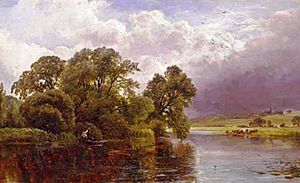
In 1763, a new group called the Burton Boat Company was formed. Samuel Lloyd's father, who owned the mill later, was a small investor in this company. One of the things the company owned was the mill itself. This might have been a way for travelers to avoid paying the river toll.
The Trent continued to be used for transporting goods, including items from Burton upon Trent that could be sent east and even to countries like those in the Baltic Sea region. However, the river could not compete with the new Trent and Mersey Canal. Because of this, the river transport business at King's Mill closed down in 1805.
The Mill and the Lloyd Family
When the river transport business stopped in 1805, a Quaker named Samuel Lloyd took over the lease on the mill. His father had been one of the earlier owners. Since Samuel was a banker, he could manage the mill business mostly from his offices in Birmingham.
The mill was used to grind plaster, flints (for pottery), and dyestuffs (for colors). It's said that the bank's old papers don't mention King's Mill much. But one note does say: "Cousin Samuel has gone to visit his Flint mills."
King's Mill Ferry
The ferry at King's Mill was one of many ferries recorded along the Trent in the Domesday Book. These ferries were important because they earned money. In 1829, a historian named Glover listed the King's Mill ferry and the nearby Weston Cliff crossing as important ferries in Derbyshire. Other main ferries were at Stapenhill, Walton on Trent, Willington, and Twyford.
Most of these crossing points also had shallow places called fords where people could walk or ride across the river, including King's Mill. However, it was noted that only local people would use these fords because they were considered too dangerous for visitors.
The chain ferry at King's Mill was run for many years by a woman named Polly Rowbottom. She lived on the Castle Donington side of the river. Travelers would ring a bell to call for the ferry. But Mrs. Rowbottom would only come if she wasn't busy with her house chores, which often meant a long wait!
People would pay a penny to get into the boat. Then, Polly would stand up and pull the boat across by hand, using a long chain that stretched across the river.
During a flood in the late 1930s, the ferry boat was swept away downstream to Trent Lock. It had to be brought back by a wagon and a team of horses, because Polly didn't want to row the boat all that way back against the strong current. The ferry kept running until the Second World War. You can still see the landing stage and one of the posts that held the chain on the Weston side of the river today.


